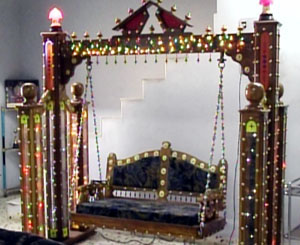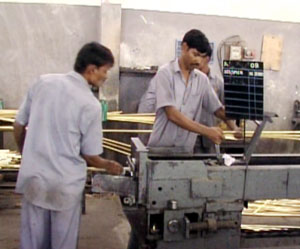 |
|
|
German convict teaches yoga to Uttaranchal jail inmates
Udhamsinghnagar (Uttaranchal): A German convict, now undergoing
a 12-year-long sentence in the jail here, is using his incarceration
to teach yoga to other inmates. Kurt Harman was arrested by the police
in 2001 for possession of illegal drugs. Since his shift to the Sitarganj
prison in February from Haridwar, Harman has been teaching yoga to
his fellow inmates. Harman says that he learnt yoga from a book more
than 20 years ago in Nepal and says his main objective is to help
other prisoners lead less stressful lives. A drill has been put in
place in the jail, whereby inmates attend yoga classes both in the
morning and in the evening. Harman initially had some trouble teaching
yoga to the inmates as not many of them could understand English.
To counter this communication deficiency, Harman picked up Hindi and
is now able to converse with other inmates in broken Hindi. The prisoners
say they have benefited from the yoga classes. "Yoga represents a
devotional form.The life led in a prison disturbs our mind. But yoga
helps in stabilising the mind. We can concentrate. Also, when we lead
our lives in confinement, we get infected from a number of diseases.
Yoga has the power to cure and prevent such diseases," said Manjit
Bedi, one of the convicts. Such has been Harman's influence, that
the prisoners have also taken to cooking and farming. The prison set
up in 1960 houses 360 convicts. Indian silk going global (Go to Top) New
Delhi: The production of silk, the queen of all fabrics, is historically
one of India's most important industries. India produces a variety
of silks called Mulberry, Tasar, Muga and Eri, based on the feeding
habit of the cocoons. The sericulture industry employs over 700,000
farm families and is concentrated in Karnataka, Tamilnadu and Andhra
Pradesh and to a lesser extent Assam and West Bengal. Karnataka accounts
for more than 70 percent of the country's silk production. Sericulture
is one industry which is beneficial to the agriculturists. As in today
56 lakhs people are dependent on the sericulture industry, 5.6 million
people out of which 4.7 million are agriculturists. The others are
reelers, weavers etc, said H. Hanumanthappa, Chairman, Central Silk
Board The bulk of Indian silk thread and silk cloth is consumed domestically.
The present market context for silk in the country is one of vigorously
growing internal demand for silk fabrics, with growth rates of above
10 percent per year. With substantial government and international
subsidies for silk projects and marketing schemes, the industry has
been expanding rapidly over the last few years. Silk exports too are
growing rapidly. Germany is the largest consumer of Indian silk. "We
have demands from the international market. We get orders from Japan
and England as well, for our muga (a kind of silk) products, said
Deepak Bharali, a silk producer. "Today only China and India are the
producers in silk. Thailand, Uzbekistan also produce silk but the
quantity is very small. So we will have to keep this raw silk and
fabrics for them to continue in the market. Only two countries can
do it. India is the largest consumer of silk fabrics by way of sarees
and so many other things. So we will have to improve our silk culture,
said T.V.Muruthi, another silk trader. Today the world's production
of silk stands at 95,858 metric tons, out of which China produces
68,000 metric tons and India's share is 16,000 metric tons. With better
infrastructure facility, the sericulture industry could improve its
productivity to 15 per cent as against the current nine per cent.
Today the Indian silk industry is already a major player in the global
scenario and the growth prospects for the industry seem to be bullish.
Measures like the encouragement of further technological and economic
research in the various aspects of sericulture, standardization and
quality control of silk and silk products and rationalization of marketing
and stabilization of prices of silk cocoons and raw silk it could
expand rapidly than ever before. Intoxicating Goa expects a good Feni season ahead (Go to Top) Mashem (Goa): Cashew farmers of Goa are a happy lot nowadays, with a bumper cashew crop this season they are sure of producing a bountiful of "feni", a local liquor-based brew usually made from ripe cashew kernels. Producing feni is one of the most popular part time businesses of the cultivators here. Cashew feni, which is brewed during the months of April and May, provides them with extra easy money. The easy-to-manufacture and extremely cheap liquor helps each farmer earn as much as Rs.50,000 in a short span of three months. Feni is made by using the traditional method where the cashew apples are manually crushed in a Coimbi (a rock on the hill which is carved or shaped like a basin) with an outlet for the juice. The juice is then collected in a huge earthen pot called Kodem, half buried in the ground, which is later distilled into earthen or copper pots. Apart from Goa, such brew is produced only in Brazil where it is called Caxata. Considered as the major fruit of Goa, cashew harvest starts from mid-March and the season continues till the end of May. The liquor is distilled in three steps, - Urrac, Cazulo and Feni. The juice, which trickles out in its concentrated form called Neero, is liked by many people since it helps bowel movement. Swapandeshi Faldessai, cashew cultivator and owner of a makeshift distillery, said Goa is incomplete without Feni, which is also consumed for its medicinal value. "We collect the cashew juice and process it here. It is processed twice and even more, the liquor is used in medicines also. It is very, very good and if the season is good then we can get up to 40,000-50,000 rupees earnings in just three months," said Faldessai. There
is another type of Feni, which is made from coconut and is also a
popular hard drink in the former Portuguese colony. There are about
4,000 mini traditional distilleries in Goa involved in producing cashew
Feni, with about 75 per cent of them in north part of the state and
rest in the southern region. There are over 7,000 shops, bars and
taverns in Goa selling Feni and other liquors. According to provisional
estimates, in 2004-05, India exported cashew kernels and cashew nut
shell liquid worth 260 billion rupees as against 180 billion rupees
in 2003-04. Total cashew exports from India in 2004-05 (April-March)
are estimated at 125,000 tonnes. India is world's largest cashew producer
with a 50 percent share of the world market, followed by Brazil and
Vietnam. New methods like drum roasting and steam roasting have also
replaced the old methods of ground roasting, iron-pan roasting and
shelling by hammering the nut with either hard stones or bamboo sticks.
The cashew industry in India provides direct employment to over 35
million people and another 500,000 people are employed in the farms
during the season. Besides Goa, cashew cultivation is also done in
southern Indian states of Karnataka, Tamil Nadu and eastern Orissa.
Jamnagar: Jamnagar is known for the manufacture of brass parts that can either be used for engineering goods, electrical parts or hardware. About 70 percent of the total emand of the country is met by Jamnagar. But the future of around two lakh labourers in 5000 odd units seems to be in the dark.These industries are entirely based on the import of brass scrap, the basic raw material. However, certain rules and regulations imposed by the government has affected the export-import business and two lakh workers who have come from UP, Bihar and Andhra Pradesh in search of new work. "Earlier the condition of the industry was very good. But now, sometimes we get a half day off or an off lasting for two-three days. We face monetary problems and difficulty in finding some other job," says Imtiyaz, a labourer. "The restriction levied on the import of raw materials have increased our costs by six-seven percent due to which we are unable to compete with China and we have to shut down our factory," says Himesh Shah, a factory owner. Earlier, the import of non-ferrous scrap required a certificate from supplier stating that it does not contain any arms and ammunition. But, the revised import procedures which came into effect during last October resulted in the closure of units. The present procedure includes pre-inspection certificate before shipment by government notified agencies and 100 percent examination on arrival of material at an Indian port.
"They
have taken ferrous and non-ferrous metal scraps together in one
category without considering the fact that the basic nature of both
the metal scraps are different.The government has taken this decision
in a hasty manner. They took this decision without considering our
view regarding non-ferrous metals. It has laid certain procedures
for import of metallic scrap where they have mentioned the pre-inspection
certificates from notified agencies they have prescribed," says
Jinesh Shah, Jamnagar Factory Owner's Association Executive committee
and vice-president, Jamnagar EOU Association,". "Earlier, new schemes
were launched due to which we could import duty-free material and
had no taxes. This facilitated our exports and was an edge in the
international market. But gradually, due to recent incidents the
govenment imposed these stringent rules and regulations which added
our additional costs of $100 per tonne," says Mukesh Kanakhara,
Secretary of Jamnagar Export Oriented Units Association. The entire
economy of Jamnagar is dependent on the brass units. The survival
of this industry is now at stake. If revision in import procedure
metal is not given considerable thought, time is not far when remaining
units will also have to down their shutters. References: Jamnagar
brass units face closure , India, India News, Newspaper, Indian,
News, Travel News, India Travel Times, Travel,Tourism, Tour, Tourist,
India, Times, News, Hotels, Airlines, Ayurveda, Yoga, Hindu, Taj Mahal,
Cuisine, Festival, Temple, Trekking, Hindu, Bharatanatyam, Kathakali,
Odissi, Dance, Shimla,Varanasi, Kullu, Manali, Dehra Dun, Mussourie,
Mussoorie, Haridwar, Hardwar, Rishikesh, Nainital, Delhi, Goa, Kovalam,
Darjeeling, Bodh Gaya, Kancheepuram, Kanchipuram, Thekkady, Badrinath,
Amar Nath,Vaishno Devi, Tirupati, Sabarimala, Guruvayoor, Kanyakumari,
Kodaikanal, Ooty, Chennai,
|
NOTE: Free contributions of articles and reports may be sent to editor@indiatraveltimes.com
DISCLAIMER
All Rights Reserved ©indiatraveltimes.com

